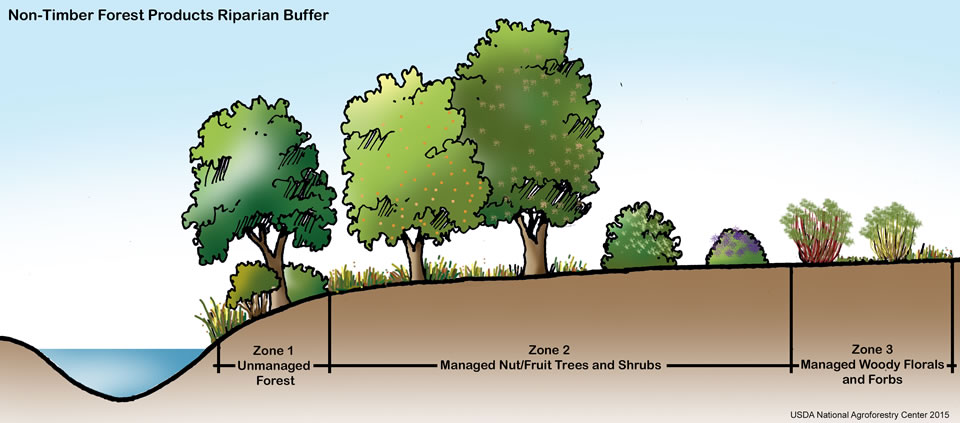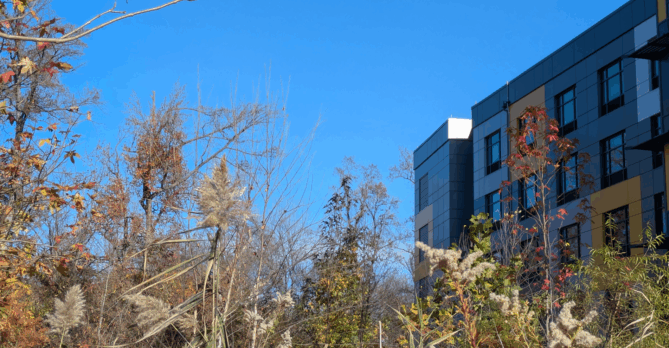
Sure October is a lot of things: The (true) onset of fall weather, Halloween, the end of Hispanic Heritage Month, National Domestic Violence Awareness Month, and more. But in our tree and environment-focused work in the District, this year it is also Riparian Buffer Month. This is the first year that the Chesapeake Conservation Landscaping Council recognizes October as Riparian Buffer Month. They’re taking the month to build awareness, promote events, and fundraise for training on riparian buffers.
It seemed only fitting, as an organization that also works to conserve landscapes, to feature a riparian (river associated) buffer project and get the word out about riparian plantings.

A quick lesson first: A riparian forest buffer is an area adjacent to a stream, lake, or wetland that contains a combination of trees, shrubs, and/or other perennial plants and is managed differently from the surrounding landscape, primarily to provide conservation benefits (more on those below!).
A Community Tree Planting project that encapsulates the importance of riparian trees is our work around Normanstone Trail, a wooded hike in the northeast of Dumbarton Oaks. Throughout 2018 and 2019, with help from our volunteers, we planted over 200 trees along Rock Creek to regain canopy out competed by invasive species! We partnered with the National Park Service on this rugged, steep, off-trail, large-scale restoration project to bring tree cover, erosion control, and stormwater management solutions to this riverside, parkway adjacent site. Understandably, we focused on trees that like ‘wet feet’ and would thrive on embankments so we planted trees like American Sycamore (Platanus occidentalis), Black willow (Salx nigra), Overcup Oak (Quercus lyrata), and Blackgum(Nyssa sylvatica), among many, many other understory, canopy, and riparian trees. We returned last year to provide invasive remediation and general establishing tree maintenance like pruning and mulching.
We mentioned some of the ways riparian buffers help conserve landscapes, but riparian trees, in particular, are critical to healthy waterways and rivers are critical to trees:
- – Many animals and insects are dependent on trees for shelter, protection, and breeding. Mayflies need trees to rest and to metamorphose into the final breeding stage of their lifecycle, trout use overhanging branches and tree roots to hide from predators, birds that hunt aquatically nest in riparian trees, and fish that travel upstream often rest in the calm pools created by fallen trees.
– Believe it or not, trees help feed aquatic animals! The woody material and leaves that fall into a river provide important nutrients and food for small organisms which become food to trout and birds.
– Shade is critical for the health of our waterways. Fish species, such as trout and salmon, are sensitive to changes in water temperature and will only lay their eggs in cool water. Most Aquatic plants prefer a mix of dappled light and shade provided from a tree’s canopy for ideal growing conditions.
– Riverside trees build an important buffer zone between the city and the river. A robust canopy captures and filters rainwater before it enters the drainage system, reducing polluting overflows into the Potomac and Anacostia Rivers.
– The roots of vegetation, including trees, reduce erosion and help slow a river’s flow, increasing our city’s resilience to the effects of climate change, like intense flooding.
Tree cover has been directly linked to drinking water treatment costs, so the more canopy in a watershed, the lower the cost to treat that water. By filtering sediments and other pollutants from the water in the soil before it reaches a water source, ultimately saving us money.
Just as trees and rivers are connected, we too are deeply inspired by, thankful for, and championed by the efforts of our partners in crime – local nonprofits that are committed to making the Anacostia and Potomac Rivers the best they can be. As city dwellers, we are all in this together.


